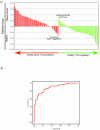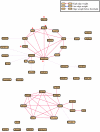Gene expression profiling of peripheral blood cells for early detection of breast cancer
- PMID: 20078854
- PMCID: PMC2880427
- DOI: 10.1186/bcr2472
Gene expression profiling of peripheral blood cells for early detection of breast cancer
Abstract
Introduction: Early detection of breast cancer is key to successful treatment and patient survival. We have previously reported the potential use of gene expression profiling of peripheral blood cells for early detection of breast cancer. The aim of the present study was to refine these findings using a larger sample size and a commercially available microarray platform.
Methods: Blood samples were collected from 121 females referred for diagnostic mammography following an initial suspicious screening mammogram. Diagnostic work-up revealed that 67 of these women had breast cancer while 54 had no malignant disease. Additionally, nine samples from six healthy female controls were included. Gene expression analyses were conducted using high density oligonucleotide microarrays. Partial Least Squares Regression (PLSR) was used for model building while a leave-one-out (LOO) double cross validation approach was used to identify predictors and estimate their prediction efficiency.
Results: A set of 738 probes that discriminated breast cancer and non-breast cancer samples was identified. By cross validation we achieved an estimated prediction accuracy of 79.5% with a sensitivity of 80.6% and a specificity of 78.3%. The genes deregulated in blood of breast cancer patients are related to functional processes such as defense response, translation, and various metabolic processes, such as lipid- and steroid metabolism.
Conclusions: We have identified a gene signature in whole blood that classifies breast cancer patients and healthy women with good accuracy supporting our previous findings.
Figures


Similar articles
-
A new statistical method for curve group analysis of longitudinal gene expression data illustrated for breast cancer in the NOWAC postgenome cohort as a proof of principle.BMC Med Res Methodol. 2016 Mar 5;16:28. doi: 10.1186/s12874-016-0129-z. BMC Med Res Methodol. 2016. PMID: 26944545 Free PMC article.
-
Peripheral blood transcriptome identifies high-risk benign and malignant breast lesions.PLoS One. 2020 Jun 4;15(6):e0233713. doi: 10.1371/journal.pone.0233713. eCollection 2020. PLoS One. 2020. PMID: 32497068 Free PMC article.
-
Early detection of breast cancer based on gene-expression patterns in peripheral blood cells.Breast Cancer Res. 2005;7(5):R634-44. doi: 10.1186/bcr1203. Epub 2005 Jun 14. Breast Cancer Res. 2005. PMID: 16168108 Free PMC article.
-
Digital breast tomosynthesis compared to diagnostic mammographic projections (including magnification) among women recalled at screening mammography: a systematic review for the European Commission Initiative on Breast Cancer (ECIBC).Cancer Med. 2021 Apr;10(7):2191-2204. doi: 10.1002/cam4.3803. Epub 2021 Mar 5. Cancer Med. 2021. PMID: 33675147 Free PMC article.
-
Early detection of breast cancer: new biomarker tests on the horizon?Mol Diagn Ther. 2009 Dec 1;13(6):349-57. doi: 10.1007/BF03256340. Mol Diagn Ther. 2009. PMID: 19925032 Review.
Cited by
-
Gene expression analysis of peripheral blood cells reveals Toll-like receptor pathway deregulation in colorectal cancer.PLoS One. 2013 May 1;8(5):e62870. doi: 10.1371/journal.pone.0062870. Print 2013. PLoS One. 2013. PMID: 23650534 Free PMC article.
-
Pathway-based Biomarkers for Breast Cancer in Proteomics.Cancer Inform. 2015 Feb 9;13(Suppl 5):101-8. doi: 10.4137/CIN.S14069. eCollection 2014. Cancer Inform. 2015. PMID: 25972728 Free PMC article.
-
Cancer type prediction based on copy number aberration and chromatin 3D structure with convolutional neural networks.BMC Genomics. 2018 Aug 13;19(Suppl 6):565. doi: 10.1186/s12864-018-4919-z. BMC Genomics. 2018. PMID: 30367576 Free PMC article.
-
Exosomes as divine messengers: are they the Hermes of modern molecular oncology?Cell Death Differ. 2015 Jan;22(1):34-45. doi: 10.1038/cdd.2014.130. Epub 2014 Sep 19. Cell Death Differ. 2015. PMID: 25236394 Free PMC article. Review.
-
The Possible Influence of Mediterranean Diet on Extracellular Vesicle miRNA Expression in Breast Cancer Survivors.Cancers (Basel). 2020 May 26;12(6):1355. doi: 10.3390/cancers12061355. Cancers (Basel). 2020. PMID: 32466456 Free PMC article.
References
-
- Cancer Registry of Norway. Cancer in Norway 2007. Cancer incidence, mortality, survival and prevalence in Norway. Bray, F. 2008. Ref Type 2007: Report.
Publication types
MeSH terms
LinkOut - more resources
Full Text Sources
Other Literature Sources
Medical
Molecular Biology Databases

